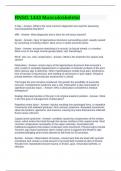RNSG 1443 Musculoskeletal
X-Ray - Answer- What is the most common diagnostic test used for assessing
musculoskeletal disorders?
MRI - Answer- What diagnostic test is done for soft tissue trauma?
Sprain - Answer- injury to ligamentous structures surrounding a joint; usually caused
by wrenching or twisting motion. Most occur in ankle and knee joints.
Strain - Answer- excessive stretching of a muscle, its fascial sheath, or a tendon.
Most occur in the large muscle groups (back, calf, hamstrings).
RICE- rest, ice, cold, compression - Answer- What is the treatment for sprains and
strains?
Dislocation - Answer- severe injury of the ligamentous structures that surround a
joint; results in complete displacement or separation of articular surfaces of the joint.
Most obvious sign is deformity. Other manifestations include local pain, tenderness,
loss of function of injured part, and swelling of soft tissues in joint region. Requires
prompt attention. Neurovascular assessment is critical.
The longer the joint remains unreduced, the greater the possibility of avascular
necrosis. Compartment syndrome also a risk. Dislocation is also associated w/
significant vascular injury. - Answer- Why is dislocation considered a medical
emergency?
Realign dislocated portion of the join in its original anatomic position - Answer- What
is the first goal of management of dislocation?
Repetitive strain injury - Answer- injuries resulting from prolonged force, or repetitive
movements and awkward postures. AKA overuse syndrome. Repeated movements
strain the tendons, ligaments, and muscles, causing tiny tears that become inflamed.
Exact cause unknown.
Carpal tunnel syndrome - Answer- condition caused by compression of the median
nerve, which enters the hand through the narrow confines of the carpal tunnel. Most
common compression neuropathy in the upper extremity. Associated with
hobbies/occupations that require continuous wrist movement. Physical signs include
Timmel's sign (hand numbness when median nerve is tapped) and Phalen's sign
(numbness/tingling when wrists allowed to fall freely for 60 seconds).
Bursitis - Answer- inflammation of bursae—closed sacs that are lined with synovial
membrane and contain a small amount of synovial fluid; located at sites of friction.
Results from repeated/excessive trauma or friction, gout, rheumatoid arthritis, or
infection.
, Fracture - Answer- a disruption or break in the continuity of the bone structure.
Classified as displaced (open) or nondisplaced (closed) depending on
communication or noncommunication with the external environment. Signs include
immediate localized pain, decreased function, and inability to bear weight or use
affected part. Obvious bone deformity may be present. Require nursing assessments
of the peripheral vasculature (color, temperature, capillary refill, peripheral pulses,
and edema) and neurologic systems (sensation, motor function, and pain).
Transverse - Answer- fracture in which the line of the fracture extends across the
bone shaft at a right angle to the longitudinal axis
Spiral - Answer- fracture in which the line of the fracture extends in a spiral direction
along the shaft of the bone
Greenstick - Answer- incomplete fracture with one side splintered and the other side
bent
Comminuted - Answer- fracture with more than two fragments; smaller fragments
appear to be floating
Oblique - Answer- fracture in which the line of the fracture extends at an angle
Pathologic - Answer- spontaneous fracture at the site of a bone disease
Stress - Answer- fracture that occurs in normal or abnormal bone that is subject to
repeated stress such as from jogging or running.
Colle's fracture - Answer- fracture of the distal radius. Manifestations are pain,
swelling, and obvious deformity of the wrist. It is usually managed by closed
manipulation, immobilization by splint or a cast, or, if displaced, by internal or
external fixation.
Assess for neurovascular integrity (circulation and pulses!) below the injury - next
splint/immobilize the fracture. - Answer- After arriving on the scene of a possible
traumatic bone injury what should be the first nursing intervention? (After that you
have assessed that your patient is breathing)
Compartment syndrome - Answer- condition in which elevated compartmental
pressure within a confined myofascial compartment compromises the neurovascular
function of tissues within that space. Causes capillary perfusion to be reduced below
a level necessary for tissue viability. Two causes are decreased compartment size r/t
restrictive dressings, splints, casts, excessive traction, or premature closing of fascia
& increased compartment contents r/t bleeding, edema, chemical response to
snakebite, or IV infiltration.
6 P's of compartment syndrome - Answer- Paresthesia, Pain distal to injury not
relieved by opioids, Pressure increase in the compartment, Pallor w/ coolness and
loss of color, Paralysis/loss of function, and Pulselessness




